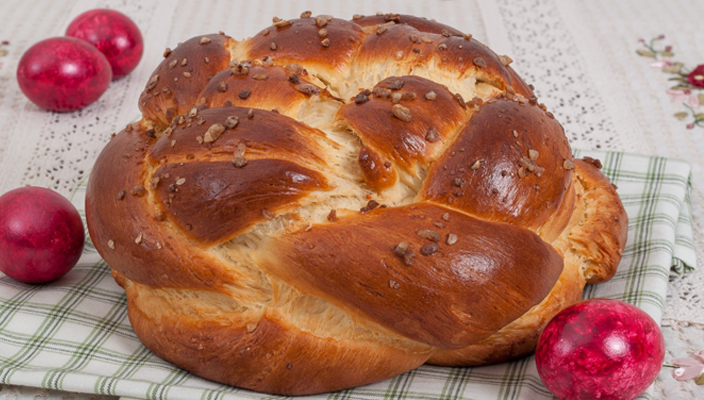
Special Blessings for a Sweet New Year
It is a tradition to place a dish of apples and honey on the table on Rosh HaShanah; many families also serve a pomegranate. According to tradition, there are several reasons for placing a pomegranate on the holiday table to eat and enjoy: Firstly, it has a crown shape like challah, and secondly, its many seeds can symbolize our hope that each of us will do many good deeds and enjoy many blessings in the coming year.
Pick up a slice of apple, dip it in honey, and say:
Baruch atah Adonai, Eloheinu melech ha-olam, borei p’ri ha-eitz.
We praise You, Eternal God, Sovereign of the universe, Creator of the fruit of the tree.
Then add:
Y’hi ratzon mil’fanecha, Adonai Eloheinu veilohei avoteinu v’imoteinu, shet’chadeish aleinu shanah tovah um’tukah.
May it be Your will, Eternal our God, that this be a good and sweet year for us.
Eat the apple dipped in honey and, if you wish, challah dipped in honey. This is also the time to enjoy the pomegranate, if you've added that to your holiday table. Now begin the holiday meal!
Tashlich
During the High Holidays, usually on the first day of Rosh HaShanah, it is a tradition to go to a nearby body of water and symbolically cast away our sins or wrongdoings from the past year in a ceremony called Tashlich. This year, take some bread crumbs - or pebbles, to be more environmentally friendly - as a family to a nearby lake or stream to perform this ceremonial casting away. You may choose to name your mistakes aloud quietly or just think them to yourself. Conclude by reading a meaningful verse about forgiveness or singing a song together. Share your wrongdoings symbolically with the birds and fish, and enjoy the family time outside together. Learn more in this Tashlich video.
Practicing Repentence
Jewish tradition teaches that the sounding of the shofar is a wake-up call, causing Jews around to world to review and rethink the past year. This is a time to ask forgiveness of people and an opportunity for a fresh start.
Children can learn the steps to t’shuvah, repentance, that Maimonides, a 12th-century sage, taught centuries ago.
- Cheshbon Hanefesh: Take an accounting of the soul. Jews ask, “What have I done right and what have I done wrong this year?” Share with someone or write these reflections in a journal.
- Apologize to those that have been hurt or wronged during the past year.
- Make a plan for behavior in the future.
- Through prayer, ask God for forgiveness.
How does one know if one has truly repented? The sages teach that if a person has truly repented, he or she will choose differently and appropriately when facing the same situation again.
Rosh HaShanah Crafts and Outings
- Create easy handprint cards with younger children to send to friends and family to ring in the Jewish new year.
- Use apples and red paint to do apple paintings, a quick craft for kids ages 3 to 6.
- Create sparkly Styrofoam apples to decorate your Rosh HaShanah dinner table.
- Try one of these fun shofar activities with your kids to learn more about the different blasts of the shofar.
- Make a honey dish... out of an apple!
- Go apple-picking. If apples grow locally, organize a family adventure. No apples? Do some investigating to find a place to pick another fruit for the Rosh HaShanah meal.
- Create a Family Blessing Journal. The Talmud teaches that we are to say 100 blessings each and every day. This is a very worthy goal for which to strive, so why not begin by recording the blessings your family experiences during this Rosh HaShanah holiday? Continue through the next 10 days until Yom Kippur, encouraging family members to take turns writing in the journal, adding pictures and illustrations. During quiet time on Yom Kippur, look through the journal and talk about your hopes and goals for the coming year.
- Make or buy a challah cover that your children can decorate themselves. A simple challah cover may be made with a hemmed square or rectangle of fabric in the dimensions desired; usually 20”x20” or 16”x20” works well. Visit a fabric store with your children and choose a special pattern, or use a light color (even a white cloth napkin will work) and decorate it with fabric crayons or markers. Sew on a decorative ribbon as a border.
- It is a Sephardic tradition to prepare a sweet-smelling apple to ward off feelings of faintness during the Yom Kippur fast. This is an activity you can easily share with your children before Yom Kippur. Provide them with apples and cloves, and direct them to stud the apple with the cloves. Have the kids present these completed apples to family members who are fasting. The faster brings the apple along to the synagogue on Yom Kippur and when hunger pangs hit, a sniff of it will relieve ill feelings.